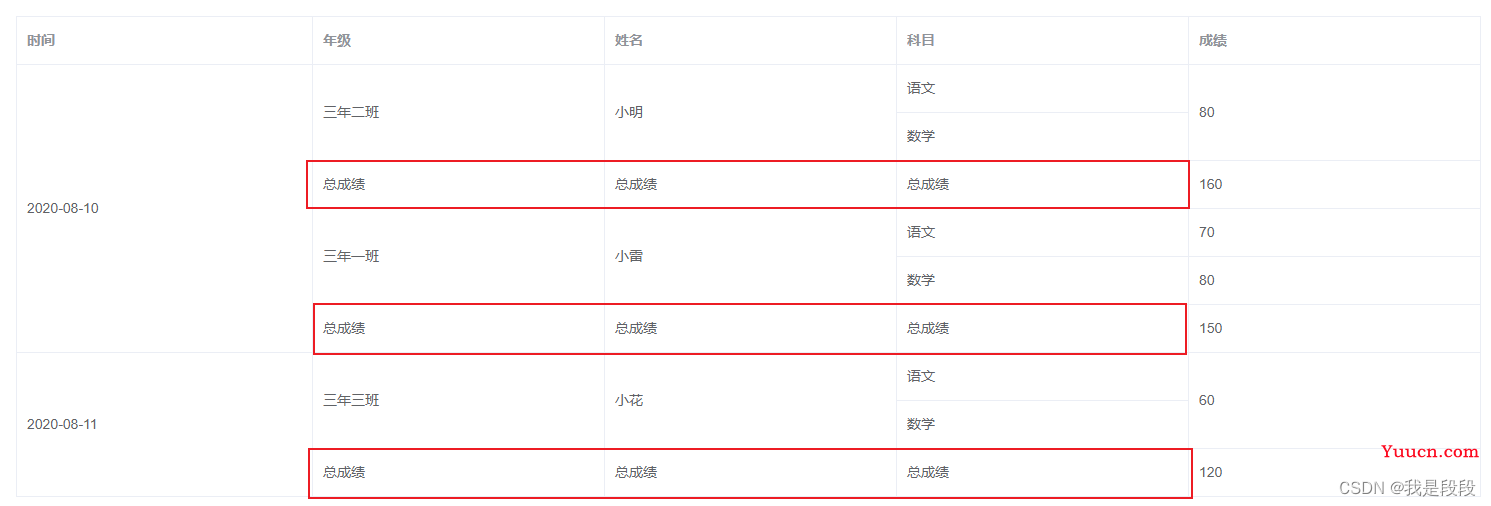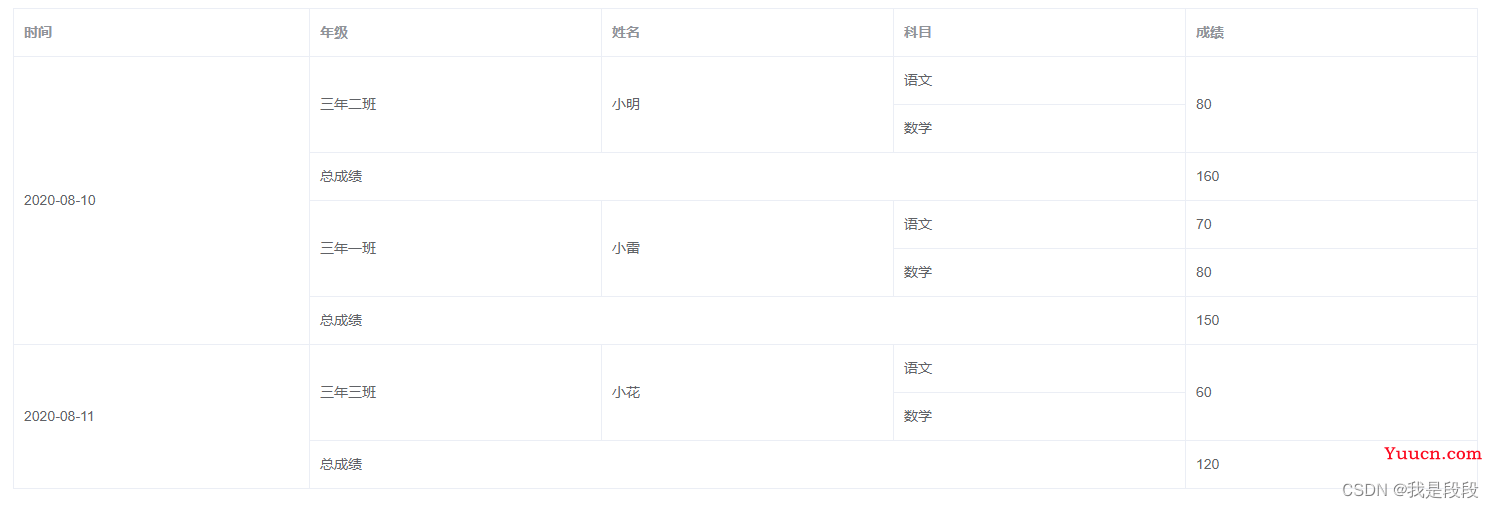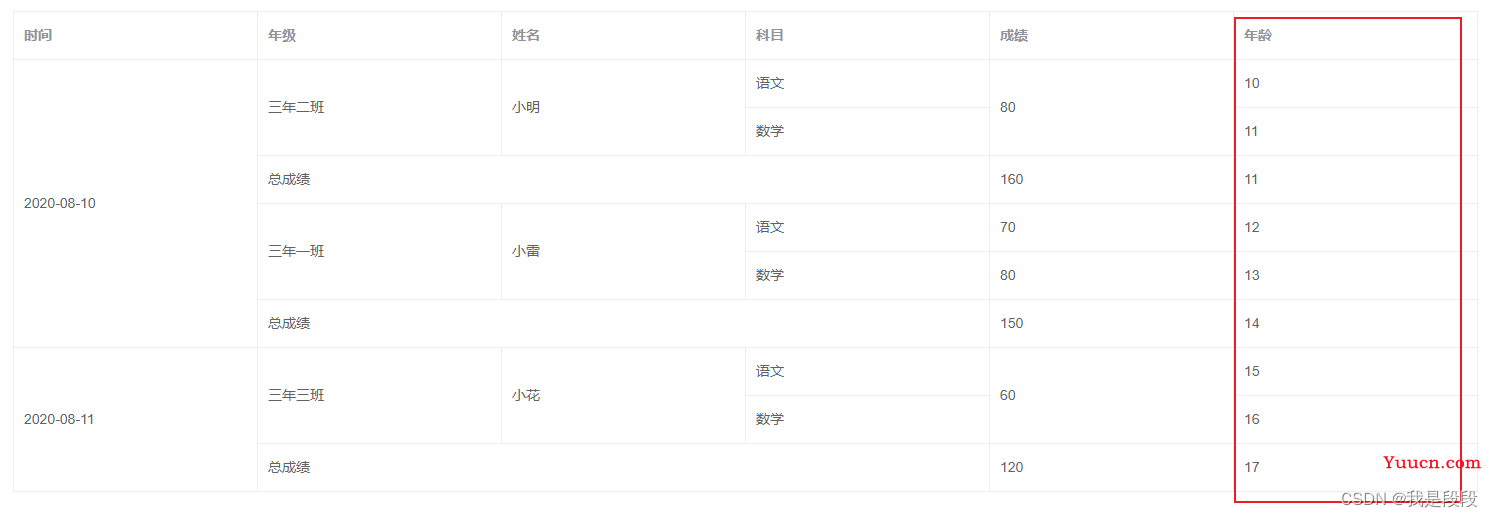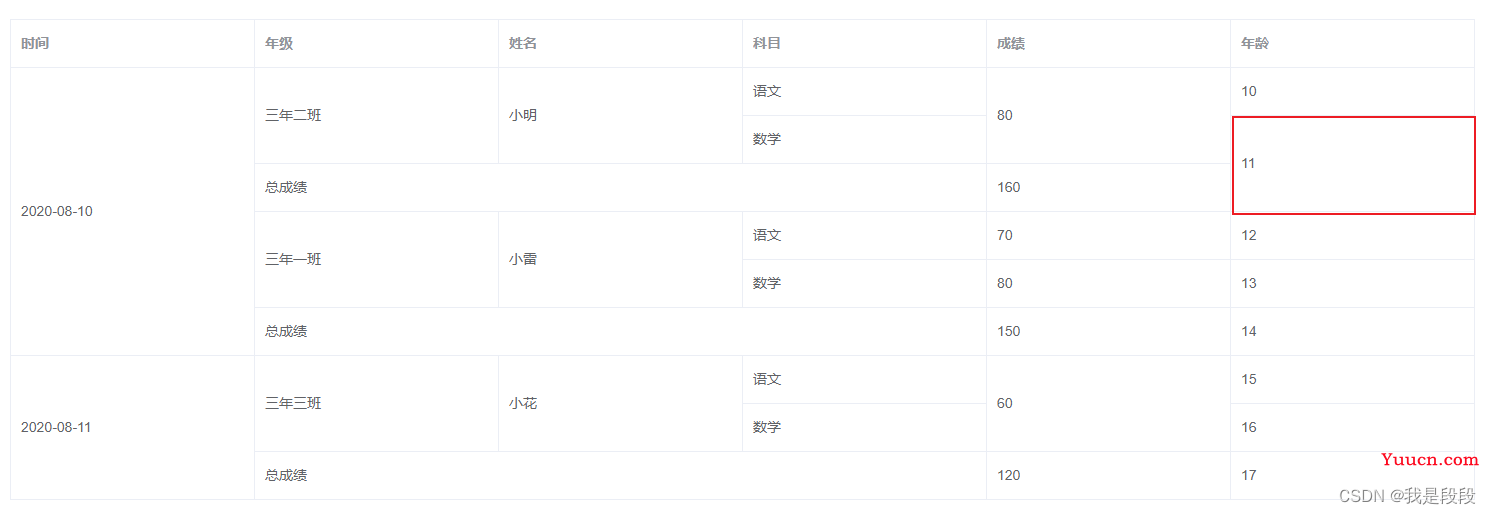📝 个人简介
⭐ 个人主页:我是段段🙋
🍊 博客领域:编程基础、前端💻
🍅 写作风格:干货!干货!都是干货!
🍑 精选专栏:Vue
🛸 支持段段:点赞👍、收藏⭐、留言💬
文章目录
- 前言
- 1、合并行
- 2、合并行列
前言
在写项目的时候有时候会经常遇到把行和列合并起来的情况,因为有些数据是重复渲染的,不合并行列会使表格看起来非常的混乱,如下:

而我们想要的数据是下面这种情况,将重复的行进行合并,使表格看起来简单明了,如下:

1、合并行
所谓的合并行就是将多行相同的数据变成一行来显示,直接上代码,页面的布局比较简单
<template>
<div class="table">
<el-table :data="tableData" :span-method="objectSpanMethod" border style="width: 100%">
<el-table-column prop="time" label="时间"></el-table-column>
<el-table-column prop="grade" label="年级"></el-table-column>
<el-table-column prop="name" label="姓名"></el-table-column>
<el-table-column prop="subjects" label="科目"></el-table-column>
<el-table-column prop="score" label="成绩"></el-table-column>
</el-table>
</div>
</template>
span-method是el-table上属性,其值是一个函数,objectSpanMethod方法是用来处理合并行的返回值,tableData数据如下:
tableData: [
{ time: '2020-08-10', grade: '三年二班', name: '小明', subjects: '语文', score: 80 },
{ time: '2020-08-10', grade: '三年二班', name: '小明', subjects: '数学', score: 80 },
{ time: '2020-08-10', grade: '三年一班', name: '小雷', subjects: '语文', score: 70 },
{ time: '2020-08-10', grade: '三年一班', name: '小雷', subjects: '数学', score: 80 },
{ time: '2020-08-11', grade: '三年三班', name: '小花', subjects: '语文', score: 60 },
{ time: '2020-08-11', grade: '三年三班', name: '小花', subjects: '数学', score: 60 },
],
mergeObj: {}, // 用来记录需要合并行的下标
mergeArr: ['time', 'grade', 'name', 'subjects', 'score'] // 表格中的列名
首先需要对数据就行处理,就是比较当前行与上一行的值是否相等(如果是第一行数据,直接将值赋值为1)
在mounted中调用数据初始化数据的方法,如下:
mounted() {
this.getSpanArr(this.tableData);
}
// getSpanArr方法
getSpanArr(data) {
this.mergeArr.forEach((key, index1) => {
let count = 0; // 用来记录需要合并行的起始位置
this.mergeObj[key] = []; // 记录每一列的合并信息
data.forEach((item, index) => {
// index == 0表示数据为第一行,直接 push 一个 1
if(index === 0) {
this.mergeObj[key].push(1);
} else {
// 判断当前行是否与上一行其值相等 如果相等 在 count 记录的位置其值 +1 表示当前行需要合并 并push 一个 0 作为占位
if(item[key] === data[index - 1][key]) {
this.mergeObj[key][count] += 1;
this.mergeObj[key].push(0);
} else {
// 如果当前行和上一行其值不相等
count = index; // 记录当前位置
this.mergeObj[key].push(1); // 重新push 一个 1
}
}
})
})
}
数据处理好之后就可以调用objectSpanMethod方法了,如下:
// objectSpanMethod方法
// 默认接受四个值 { 当前行的值, 当前列的值, 行的下标, 列的下标 }
objectSpanMethod({ row, column, rowIndex, columnIndex }) {
// 判断列的属性
if(this.mergeArr.indexOf(column.property) !== -1) {
// 判断其值是不是为0
if(this.mergeObj[column.property][rowIndex]) {
return [this.mergeObj[column.property][rowIndex], 1]
} else {
// 如果为0则为需要合并的行
return [0, 0];
}
}
}
合并后的结果就是我们想要的形式:

合并行完整的代码如下:
<template>
<div class="table">
<el-table :data="tableData" :span-method="objectSpanMethod" border style="width: 100%">
<el-table-column prop="time" label="时间"></el-table-column>
<el-table-column prop="grade" label="年级"></el-table-column>
<el-table-column prop="name" label="姓名"></el-table-column>
<el-table-column prop="subjects" label="科目"></el-table-column>
<el-table-column prop="score" label="成绩"></el-table-column>
</el-table>
</div>
</template>
<script>
export default {
name: 'Table',
data() {
return {
tableData: [
{ time: '2020-08-10', grade: '三年二班', name: '小明', subjects: '语文', score: 80 },
{ time: '2020-08-10', grade: '三年二班', name: '小明', subjects: '数学', score: 80 },
{ time: '2020-08-10', grade: '三年一班', name: '小雷', subjects: '语文', score: 70 },
{ time: '2020-08-10', grade: '三年一班', name: '小雷', subjects: '数学', score: 80 },
{ time: '2020-08-11', grade: '三年三班', name: '小花', subjects: '语文', score: 60 },
{ time: '2020-08-11', grade: '三年三班', name: '小花', subjects: '数学', score: 60 },
],
mergeObj: {},
mergeArr: ['time', 'grade', 'name', 'subjects', 'score'],
};
},
methods: {
getSpanArr(data) {
this.mergeArr.forEach((key, index1) => {
let count = 0; // 用来记录需要合并行的起始位置
this.mergeObj[key] = []; // 记录每一列的合并信息
data.forEach((item, index) => {
// index == 0表示数据为第一行,直接 push 一个 1
if(index === 0) {
this.mergeObj[key].push(1);
} else {
// 判断当前行是否与上一行其值相等 如果相等 在 count 记录的位置其值 +1 表示当前行需要合并 并push 一个 0 作为占位
if(item[key] === data[index - 1][key]) {
this.mergeObj[key][count] += 1;
this.mergeObj[key].push(0);
} else {
// 如果当前行和上一行其值不相等
count = index; // 记录当前位置
this.mergeObj[key].push(1); // 重新push 一个 1
}
}
})
})
},
// 默认接受四个值 { 当前行的值, 当前列的值, 行的下标, 列的下标 }
objectSpanMethod({ row, column, rowIndex, columnIndex }) {
// 判断列的属性
if(this.mergeArr.indexOf(column.property) !== -1) {
// 判断其值是不是为0
if(this.mergeObj[column.property][rowIndex]) {
return [this.mergeObj[column.property][rowIndex], 1]
} else {
// 如果为0则为需要合并的行
return [0, 0];
}
}
}
},
mounted() {
this.getSpanArr(this.tableData);
}
};
</script>
<style lang="stylus" scoped>
.table
height 100vh
width 100%
padding 40px
box-sizing border-box
/deep/ .el-table__body tr:hover > td
background-color: #fff;
</style>
2、合并行列
调整下数据,如下:
tableData: [
{ time: '2020-08-10', grade: '三年二班', name: '小明', subjects: '语文', score: 80 },
{ time: '2020-08-10', grade: '三年二班', name: '小明', subjects: '数学', score: 80 },
{ time: '2020-08-10', grade: '总成绩', name: '总成绩', subjects: '总成绩', score: 160 },
{ time: '2020-08-10', grade: '三年一班', name: '小雷', subjects: '语文', score: 70 },
{ time: '2020-08-10', grade: '三年一班', name: '小雷', subjects: '数学', score: 80 },
{ time: '2020-08-10', grade: '总成绩', name: '总成绩', subjects: '总成绩', score: 150 },
{ time: '2020-08-11', grade: '三年三班', name: '小花', subjects: '语文', score: 60 },
{ time: '2020-08-11', grade: '三年三班', name: '小花', subjects: '数学', score: 60 },
{ time: '2020-08-11', grade: '总成绩', name: '总成绩', subjects: '总成绩', score: 120 }
],
可以看到上面的数据多了一行总成绩,现在的数据在页面显示效果如下:

可以看到总成绩的三个列并没有合并,并不是我们想要的效果,所以需要换一种思路来处理数据
页面的布局也有所调整,如下:
<template>
<div class="table">
<el-table :data="tableData" :span-method="objectSpanMethods" border style="width: 100%">
<template v-for="cols in colConfigs">
<!-- 无需合并的列 -->
<el-table-column
v-if="cols.type === 'label' && !cols.children"
:key="cols.prop"
:prop="cols.prop"
:label="cols.label"
>
</el-table-column>
<!-- 需要合并的列 -->
<template v-else-if="cols.type === 'label' && cols.children">
<el-table-column
v-for="children in cols.children"
:key="children.prop"
:prop="children.prop"
:label="children.label"
/>
</template>
</template>
</el-table>
</div>
</template>
tableData中的数据就是上面调整后的,还需要声明的变量如下:
// 表格的信息 需要合并的需要放在 children 中
colConfigs: [
{
type: 'label',
children: [
{ prop: 'time', label: '时间' },
{ prop: 'grade', label: '年级' },
{ prop: 'name', label: '姓名' },
{ prop: 'subjects', label: '科目' },
{ prop: 'score', label: '成绩' }
]
}
],
// 需要合并的行列信息
mergeCols: [
{ index: 0, name: 'time' },
{ index: 1, name: 'grade' },
{ index: 2, name: 'name' },
{ index: 3, name: 'subjects' },
{ index: 4, name: 'score' },
],
// 用来记录每一个单元格的下标
tableMergeIndex: [],
首先也需要处理数据,在mounted中调用数据初始化数据的方法,如下:
mounted() {
if(this.mergeCols.length > 0) {
this.newTableMergeData();
}
}
// newTableMergeData方法
newTableMergeData() {
for (let i = 0; i < this.tableData.length; i++) {
for (let j = 0; j < this.mergeCols.length; j++) {
// 初始化行、列坐标信息
let rowIndex = 1;
let columnIndex = 1;
// 比较横坐标左方的第一个元素
if (j > 0 && this.tableData[i][this.mergeCols[j]['name']] === this.tableData[i][this.mergeCols[j - 1]['name']]) {
columnIndex = 0;
}
// 比较纵坐标上方的第一个元素
if (i > 0 && this.tableData[i][this.mergeCols[j]['name']] === this.tableData[i - 1][this.mergeCols[j]['name']]) {
rowIndex = 0;
}
// 比较横坐标右方元素
if (columnIndex > 0) {
columnIndex = this.onColIndex(this.tableData[i], j, j + 1, 1, this.mergeCols.length);
}
// 比较纵坐标下方元素
if (rowIndex > 0) {
rowIndex = this.onRowIndex(this.tableData, i, i + 1, 1, this.mergeCols[j]['name']);
}
let key = this.mergeCols[j]['index'] + '_' + i;
this.tableMergeIndex[key] = [rowIndex, columnIndex];
}
}
},
/**
* 计算列坐标信息
* data 单元格所在行数据
* index 当前下标
* nextIndex 下一个元素坐标
* count 相同内容的数量
* maxLength 当前行的列总数
*/
onColIndex(data, index, nextIndex, count, maxLength) {
// 比较当前单元格中的数据与同一行之后的单元格是否相同
if (nextIndex < maxLength && data[this.mergeCols[index]['name']] === data[this.mergeCols[nextIndex]['name']]) {
return this.onColIndex(data, index, ++nextIndex, ++count, maxLength);
}
return count;
},
/**
* 计算行坐标信息
* data 表格总数据
* index 当前下标
* nextIndex 下一个元素坐标
* count 相同内容的数量
* name 数据的key
*/
onRowIndex(data, index, nextIndex, count, name) {
// 比较当前单元格中的数据与同一列之后的单元格是否相同
if (nextIndex < data.length && data[index][name] === data[nextIndex][name]) {
return this.onRowIndex(data, index, ++nextIndex, ++count, name);
}
return count;
}
数据处理好之后就可以调用objectSpanMethods方法了,如下:
objectSpanMethods({ row, column, rowIndex, columnIndex }) {
let key = columnIndex + '_' + rowIndex;
if (this.tableMergeIndex[key]) {
return this.tableMergeIndex[key];
}
}
实现的效果图如下:

合并行列的完整代码如下:
<template>
<div class="table">
<el-table :data="tableData" :span-method="objectSpanMethods" border style="width: 100%">
<template v-for="cols in colConfigs">
<!-- 无需合并的列 -->
<el-table-column
v-if="cols.type === 'label' && !cols.children"
:key="cols.prop"
:prop="cols.prop"
:label="cols.label"
>
</el-table-column>
<!-- 需要合并的列 -->
<template v-else-if="cols.type === 'label' && cols.children">
<el-table-column
v-for="children in cols.children"
:key="children.prop"
:prop="children.prop"
:label="children.label"
/>
</template>
</template>
</el-table>
</div>
</template>
<script>
export default {
name: 'Table',
data() {
return {
tableData: [
{ time: '2020-08-10', grade: '三年二班', name: '小明', subjects: '语文', score: 80 },
{ time: '2020-08-10', grade: '三年二班', name: '小明', subjects: '数学', score: 80 },
{ time: '2020-08-10', grade: '总成绩', name: '总成绩', subjects: '总成绩', score: 160 },
{ time: '2020-08-10', grade: '三年一班', name: '小雷', subjects: '语文', score: 70 },
{ time: '2020-08-10', grade: '三年一班', name: '小雷', subjects: '数学', score: 80 },
{ time: '2020-08-10', grade: '总成绩', name: '总成绩', subjects: '总成绩', score: 150 },
{ time: '2020-08-11', grade: '三年三班', name: '小花', subjects: '语文', score: 60 },
{ time: '2020-08-11', grade: '三年三班', name: '小花', subjects: '数学', score: 60 },
{ time: '2020-08-11', grade: '总成绩', name: '总成绩', subjects: '总成绩', score: 120 }
],
// 表格的信息 需要合并的需要放在 children 中
colConfigs: [
{
type: 'label',
children: [
{ prop: 'time', label: '时间' },
{ prop: 'grade', label: '年级' },
{ prop: 'name', label: '姓名' },
{ prop: 'subjects', label: '科目' },
{ prop: 'score', label: '成绩' }
]
},
// { type: 'label', prop: 'age', label: '年龄' }
],
// 需要合并的行列信息 index必须是table表格对应的下标 不能随意修改
mergeCols: [
{ index: 0, name: 'time' },
{ index: 1, name: 'grade' },
{ index: 2, name: 'name' },
{ index: 3, name: 'subjects' },
{ index: 4, name: 'score' },
// { index: 5, name: 'age' }
],
// 用来记录每一个单元格的下标
tableMergeIndex: [],
};
},
methods: {
objectSpanMethods({ row, column, rowIndex, columnIndex }) {
let key = columnIndex + '_' + rowIndex;
if (this.tableMergeIndex[key]) {
return this.tableMergeIndex[key];
}
},
newTableMergeData() {
for (let i = 0; i < this.tableData.length; i++) {
for (let j = 0; j < this.mergeCols.length; j++) {
// 初始化行、列坐标信息
let rowIndex = 1;
let columnIndex = 1;
// 比较横坐标左方的第一个元素
if (j > 0 && this.tableData[i][this.mergeCols[j]['name']] === this.tableData[i][this.mergeCols[j - 1]['name']]) {
columnIndex = 0;
}
// 比较纵坐标上方的第一个元素
if (i > 0 && this.tableData[i][this.mergeCols[j]['name']] === this.tableData[i - 1][this.mergeCols[j]['name']]) {
rowIndex = 0;
}
// 比较横坐标右方元素
if (columnIndex > 0) {
columnIndex = this.onColIndex(this.tableData[i], j, j + 1, 1, this.mergeCols.length);
}
// 比较纵坐标下方元素
if (rowIndex > 0) {
rowIndex = this.onRowIndex(this.tableData, i, i + 1, 1, this.mergeCols[j]['name']);
}
let key = this.mergeCols[j]['index'] + '_' + i;
this.tableMergeIndex[key] = [rowIndex, columnIndex];
}
}
},
/**
* 计算列坐标信息
* data 单元格所在行数据
* index 当前下标
* nextIndex 下一个元素坐标
* count 相同内容的数量
* maxLength 当前行的列总数
*/
onColIndex(data, index, nextIndex, count, maxLength) {
// 比较当前单元格中的数据与同一行之后的单元格是否相同
if (nextIndex < maxLength && data[this.mergeCols[index]['name']] === data[this.mergeCols[nextIndex]['name']]) {
return this.onColIndex(data, index, ++nextIndex, ++count, maxLength);
}
return count;
},
/**
* 计算行坐标信息
* data 表格总数据
* index 当前下标
* nextIndex 下一个元素坐标
* count 相同内容的数量
* name 数据的key
*/
onRowIndex(data, index, nextIndex, count, name) {
// 比较当前单元格中的数据与同一列之后的单元格是否相同
if (nextIndex < data.length && data[index][name] === data[nextIndex][name]) {
return this.onRowIndex(data, index, ++nextIndex, ++count, name);
}
return count;
}
},
mounted() {
if(this.mergeCols.length > 0) {
this.newTableMergeData();
}
}
};
</script>
<style lang="stylus" scoped>
.table
height 100vh
width 100%
padding 40px
box-sizing border-box
/deep/ .el-table__body tr:hover > td
background-color: #fff;
</style>
如果用不想合并的行需要在colConfigs中调整,如下:
// 增加一个年龄属性 但是不进行合并
colConfigs: [
{
type: 'label',
children: [
{ prop: 'time', label: '时间' },
{ prop: 'grade', label: '年级' },
{ prop: 'name', label: '姓名' },
{ prop: 'subjects', label: '科目' },
{ prop: 'score', label: '成绩' }
]
},
{ type: 'label', prop: 'age', label: '年龄' }
]
效果图如下:

如果想要合并,需要在mergeCols中添加数据,如下:
mergeCols: [
{ index: 0, name: 'time' },
{ index: 1, name: 'grade' },
{ index: 2, name: 'name' },
{ index: 3, name: 'subjects' },
{ index: 4, name: 'score' },
{ index: 5, name: 'age' } // 添加需要合并的age列信息 注意index的值
],
新添加的属性合并后效果图如下:

以上就是el-table表格合并行列的内容,有不懂的地方欢迎留言讨论~